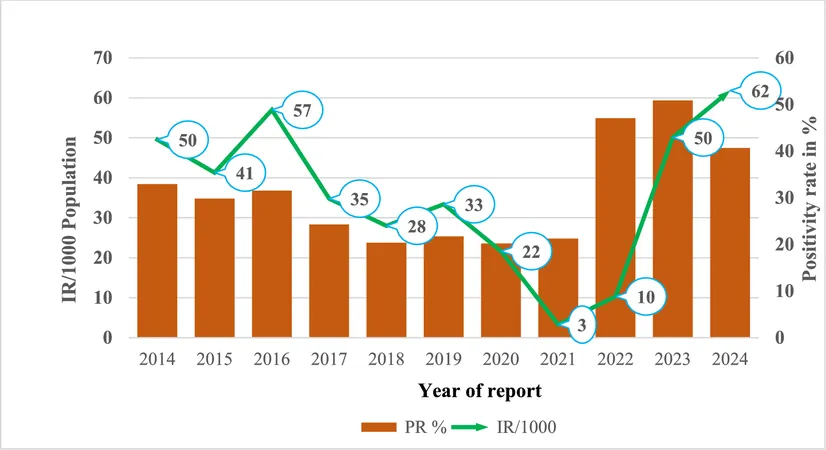
New Insights into Frontotemporal Dementia (FTD) from Phase 3 INFRONT-3 Study Revealed!
2025-04-08
Author: Rajesh
INFRONT-3 Study Overview
In an exciting presentation at the 2025 American Academy of Neurology (AAN) Annual Meeting in San Diego, researchers unveiled critical baseline characteristics from the INFRONT-3 study (NCT04374136), a pivotal phase 3 trial investigating the investigational drug latozinemab (Alector) for frontotemporal dementia (FTD) linked to GRN mutations.
Study Design and Cohorts
The INFRONT-3 trial is designed as a multicenter, randomized, double-blind, placebo-controlled study that will last approximately 96 weeks, offering valuable insights into the progression of this unique patient population afflicted by FTD. The trial's participant enrollment involved two distinct cohorts: the At-risk Cohort, defined by a Clinical Dementia Rating (CDR) plus National Alzheimer’s Disease Coordinating Center Frontotemporal Lobar Degeneration Sum of Boxes (NACC FTLD-SB) score of 0.5 or lower, along with elevated serum neurofilament light chain (NfL) levels; and the Symptomatic Cohort, which included individuals with a CDR plus NACC FTLD-SB score exceeding 0.5 and displaying clinical symptoms of behavioral variant FTD (bvFTD) or primary progressive aphasia (PPA).
Enrollment Details
Dr. Lawrence Carter, vice president of clinical development at Alector, led the presentation, which discussed the enrollment of a total of 119 participants—103 of whom were in the Symptomatic Cohort. At baseline, their global CDR scores revealed a distribution of 0 (15 participants), 0.5 (25 participants), 1 (47 participants), and 2 (32 participants). The average age of participants was 62 years, ranging from 37 to 85, with demographic data showing that 51% were women and 89% identified as Caucasian.
Cohort Differences and Findings
The baseline findings exposed notable differences between the two cohorts: the At-risk Cohort had a mean CDR-SB score of 0.0 with a median serum NfL level of 14.4 pg/mL, while the Symptomatic Cohort reported a mean CDR-SB score of 6.9 and a median serum NfL of 66.9 pg/mL. Among those in the Symptomatic Cohort, the diagnosis breakdown included 64 participants with bvFTD, 28 with PPA, and 7 with a dual diagnosis of both.
Latozinemab Mechanism of Action
Latozinemab targets the sortilin receptor to modulate progranulin (PGRN) levels, aiming to restore PGRN to its physiologic state and potentially attenuate disease progression in FTD-GRN. The trial promises to assess both the efficacy and safety of this novel treatment approach across a diverse range of disease severities.
Related Development: AL002 for Alzheimer’s Disease
In a related note, Alector’s fortunes have seen ups and downs with their investigational agent, AL002, aimed at targeting TREM2 for early-stage Alzheimer's disease (AD). Unfortunately, data from the phase 2 INVOKE-2 trial revealed that AL002 did not meet any of its endpoints, leading the company to halt the long-term extension study.
Invoke-2 Trial Results
While INVOKE-2 involved a randomized controlled design assessing various dosages of AL002, results showed no significant efficacy compared to placebo. The trial included 381 participants, predominantly older adults, and while treatment-engendered brain MRI changes were observed, especially among APOE e4 carriers, the research indicated a lack of therapeutic benefit overall.
Conclusion and Future Directions
As advancements in understanding and treating neurodegenerative diseases continue to develop, the findings from INFRONT-3 will be crucial for future therapeutic strategies in combatting Frontotemporal Dementia associated with GRN mutations.
Stay tuned for more updates and detailed coverage from AAN 2025 as groundbreaking discoveries in neurology unfold!



 Brasil (PT)
Brasil (PT)
 Canada (EN)
Canada (EN)
 Chile (ES)
Chile (ES)
 Česko (CS)
Česko (CS)
 대한민국 (KO)
대한민국 (KO)
 España (ES)
España (ES)
 France (FR)
France (FR)
 Hong Kong (EN)
Hong Kong (EN)
 Italia (IT)
Italia (IT)
 日本 (JA)
日本 (JA)
 Magyarország (HU)
Magyarország (HU)
 Norge (NO)
Norge (NO)
 Polska (PL)
Polska (PL)
 Schweiz (DE)
Schweiz (DE)
 Singapore (EN)
Singapore (EN)
 Sverige (SV)
Sverige (SV)
 Suomi (FI)
Suomi (FI)
 Türkiye (TR)
Türkiye (TR)
 الإمارات العربية المتحدة (AR)
الإمارات العربية المتحدة (AR)